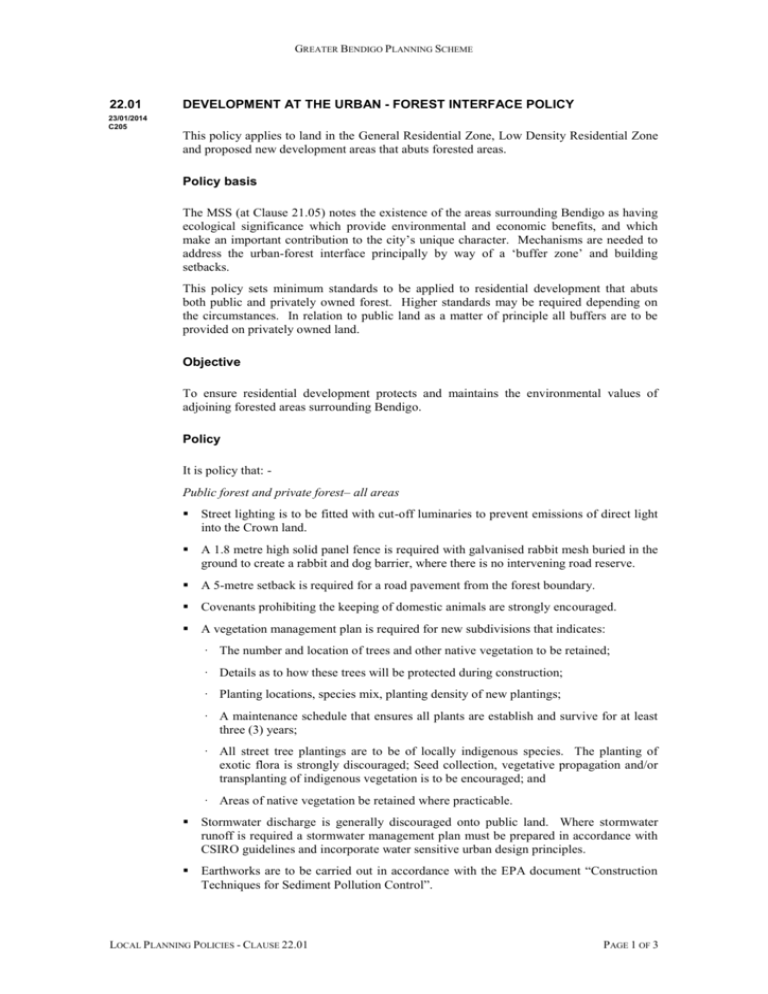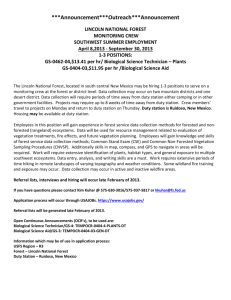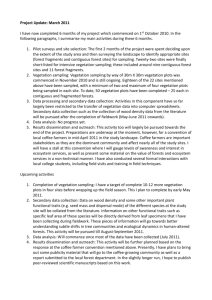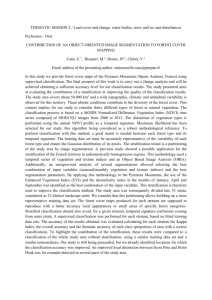22_lpp01_gben
advertisement

GREATER BENDIGO PLANNING SCHEME 22.01 DEVELOPMENT AT THE URBAN - FOREST INTERFACE POLICY 23/01/2014 C205 This policy applies to land in the General Residential Zone, Low Density Residential Zone and proposed new development areas that abuts forested areas. Policy basis The MSS (at Clause 21.05) notes the existence of the areas surrounding Bendigo as having ecological significance which provide environmental and economic benefits, and which make an important contribution to the city’s unique character. Mechanisms are needed to address the urban-forest interface principally by way of a ‘buffer zone’ and building setbacks. This policy sets minimum standards to be applied to residential development that abuts both public and privately owned forest. Higher standards may be required depending on the circumstances. In relation to public land as a matter of principle all buffers are to be provided on privately owned land. Objective To ensure residential development protects and maintains the environmental values of adjoining forested areas surrounding Bendigo. Policy It is policy that: Public forest and private forest– all areas Street lighting is to be fitted with cut-off luminaries to prevent emissions of direct light into the Crown land. A 1.8 metre high solid panel fence is required with galvanised rabbit mesh buried in the ground to create a rabbit and dog barrier, where there is no intervening road reserve. A 5-metre setback is required for a road pavement from the forest boundary. Covenants prohibiting the keeping of domestic animals are strongly encouraged. A vegetation management plan is required for new subdivisions that indicates: · The number and location of trees and other native vegetation to be retained; · Details as to how these trees will be protected during construction; · Planting locations, species mix, planting density of new plantings; · A maintenance schedule that ensures all plants are establish and survive for at least three (3) years; · All street tree plantings are to be of locally indigenous species. The planting of exotic flora is strongly discouraged; Seed collection, vegetative propagation and/or transplanting of indigenous vegetation is to be encouraged; and · Areas of native vegetation be retained where practicable. Stormwater discharge is generally discouraged onto public land. Where stormwater runoff is required a stormwater management plan must be prepared in accordance with CSIRO guidelines and incorporate water sensitive urban design principles. Earthworks are to be carried out in accordance with the EPA document “Construction Techniques for Sediment Pollution Control”. LOCAL P LANNING POLICIES - CLAUSE 22.01 PAGE 1 OF 3 GREATER BENDIGO PLANNING SCHEME Public forest – all areas A 1.2-metre “farm” style mesh fence with a continuous top rail and galvanised rabbit mesh buried in the ground to create a rabbit and dog barrier be required for fencing of the forest boundary where there is road reserve between the forest and residential development. Accessways to Crown land are to be sited at locations satisfactory to the pubic land manager and designed to prevent access by motorcycles and the like. Public forest – existing General Residential Zone or Low Density Residential Zone A 30-metre buffer will be provided from residential development (including outbuildings) to the forest boundary. A road reserve may be included within the buffer. Planting of the buffer will be based on the Ecological Vegetation Class (EVC), but will not include trees. Subdivision applications must include: · Subdivision design based upon consultation with the public land manager; · The development of biolinks to link critical vegetation; · Building envelopes; · All utility services to be placed underground in common trenches; · A fire management plan, which addresses issues such as access for emergency vehicles and fire hazard reduction; · Higher density lots in areas that have previously been disturbed and undisturbed areas left as open space, where appropriate; · EVC mapping where applicable and the protection of areas of very high, high and medium conservation significance vegetation from residential development. Public forest – proposed new development areas The responsible authority apply an Incorporated Plan Overlay to public forest – proposed new development areas, which at a minimum addresses: · The protection of areas of very high, high and medium conservation significance vegetation; · The subdivision design in consultation with the adjoining public land manager; · The development of biolinks to link critical vegetation; · The provision of building envelopes; · The placement of all utility services under ground in common trenches; · The preparation of a fire management plan, which includes issues such access for emergency vehicles and fire hazard reduction; and · Higher density lots in areas that have been previously disturbed and undisturbed areas left as public open space, where appropriate. Private forest - (areas of very high, high and medium conservation significance vegetation) – existing General Residential Zone and Low Density Residential Zone A 30-metre buffer be provided from residential development (including outbuildings) to the forest boundary. A road reserve may be included within the buffer. Planting of the buffer will be based on the EVC. If the land is identified in the Urban Vegetation Study (Stage 1), the development must demonstrate that an appropriate management regime can be introduced that will produce a positive environmental outcome. Subdivision applications should include: LOCAL P LANNING POLICIES - CLAUSE 22.01 PAGE 2 OF 3 GREATER BENDIGO PLANNING SCHEME · The development of biolinks to link critical vegetation; · Building envelopes; · Dwellings to be constructed of materials that are sympathetic with adjoining forest (ie muted tones, etc); · All utility services to be placed under ground in common trenches; · A fire management plan, which addresses issues such access for emergency vehicles and fire hazard reduction; · Higher density lots in areas that have been previously disturbed and undisturbed areas left as public open space, here appropriate; and · EVC mapping where applicable and the protection of areas of very high, high and medium conservation significance vegetation from residential development. Private forest (areas of very high, high and medium conservation significance vegetation) – proposed new development areas New residential areas that abut private forest are discouraged unless it can be demonstrated that an appropriate management regime can be introduced that will produce a positive environmental outcome for the private forest. The responsible authority apply an Incorporated Plan Overlay to private forest – proposed new development areas, which at a minimum addresses: · The protection of areas of very high, high and medium conservation significance vegetation; · The development of biolinks to link critical vegetation; · The provision of building envelopes; · The placement of all utility services under ground in common trenches; · The preparation of a fire management plan, which includes issues such access for emergency vehicles and fire hazard reduction; and · Higher density lots in areas that have been previously disturbed and undisturbed areas left as public open space or covenanted private forest, where appropriate. Notice requirement Notice of any application affected by this policy must be given in accordance with section 52(1)(c) of the Act to the person or body specified in clause 66.06 or a schedule to that clause. Reference documents Parsons Brinkerhoff, RPD Group and SGS Economics and Planning Pty Ltd, City of Greater Bendigo Residential Development Strategy, 2004 Parks Victoria – Draft Greater Bendigo National Park Management Plan 2004 (to be replaced by final version) LOCAL P LANNING POLICIES - CLAUSE 22.01 PAGE 3 OF 3







